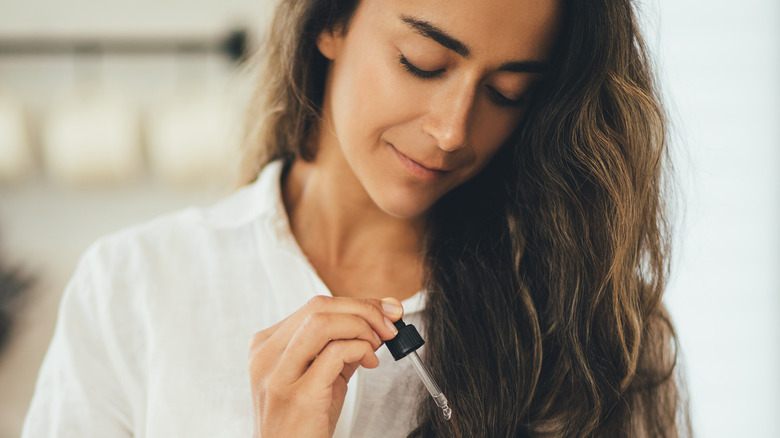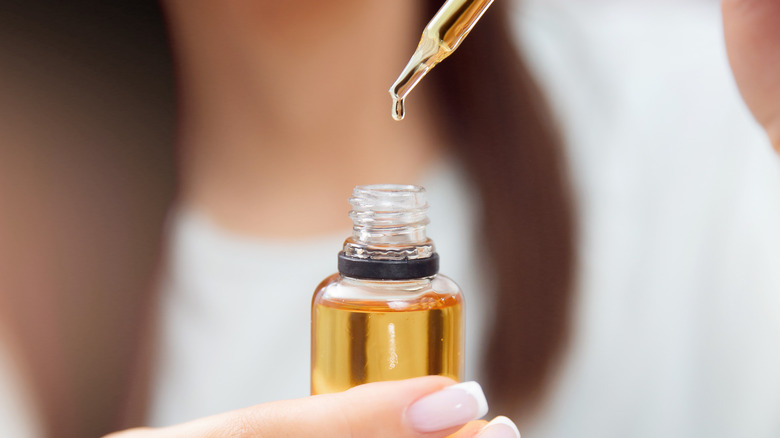Mustard Oil Could Be A Cure-All For So Many Hair & Scalp Issues
When it comes to tried-and-true home remedies for your hair, one method, in particular, is having a moment lately: hair oiling, originally known as the champi ritual. Hair oiling is currently trending on TikTok, but it is actually part of the Indian Ayurvedic practice dating back to around 5,000 years ago. Typically, a hair oiling session is pretty straightforward and involves oiling the strands of your hair and massaging your scalp with natural oils that are loaded with nutrients, which are linked to numerous hair benefits, including less frizz and increased hair growth, according to Healthline.
When it comes to hair oiling specifically, mustard oil is often thought of as an effective solution for several hair and scalp woes. As its name suggests, the oil is obtained from the seeds of the mustard plant. A common ingredient in cooking, medicines, and skin care products, mustard oil boasts antibacterial and antifungal properties. In addition, it contains a decent amount of fatty acids, making it a good moisturizer for the hair and skin, according to WebMD.
Here's why regularly oiling your hair and scalp using mustard oil could be worth trying out soon.
Benefits of using mustard oil for hair and scalp
As dermatologist Dr. Jennifer Chwalek tells Byrdie, "Mustard oil is rich in fatty acids, such as omega 3s and 6s, various minerals including calcium, iron, and zinc, as well as antioxidants such as vitamin B and E." Massaging your scalp using mustard oil can restore luster and moisture to your strands, as well as help to improve the appearance of split ends. And due to its anti-bacterial and anti-fungal properties, mustard oil can combat common issues like dandruff and hair shedding, according to a 2013 study.
Furthermore, trichologist William Gaunitz points out that the mustard seed contains anti-parasitic effects, meaning it can destroy mites, a type of parasite that lives on the human scalp and can contribute to hair loss. One important factor to keep in mind? Mites are known to feed on oil, so ground mustard powder could be a better option, according to Gaunitz.
How to treat your hair and scalp using mustard oil
Mustard oil is generally safe, but it might not be a good option for those with a mustard allergy. Before using mustard oil, do a patch test on a small part of your skin, such as the back of your ear or inner elbow to rule out a potential allergic reaction.
Application-wise, one way to do it is to gently massage a teaspoon of mustard oil into your scalp for about five minutes and then wash your hair. However, if you have a little more time on your hands, cover your head with a shower scalp after applying the oil to your scalp, then wait for about 30 minutes. This extra step will allow the oil to penetrate deeper into your scalp. To minimize any potential irritation, you may want to consider mixing mustard oil with other carrier oils like coconut or baobab.
Another technique calls for mixing ground mustard seed powder with water; for instance, you can combine ¼ of a teaspoon of mustard seed powder with two ounces of water. The reason? It can be difficult to find a pure, high-quality mustard oil that actually lives up to its claims. Plus, as mentioned above, mites feed on oil.
Depending on your hair's specific needs, you can massage your scalp with mustard oil or powder anywhere from once a week to once per month.


